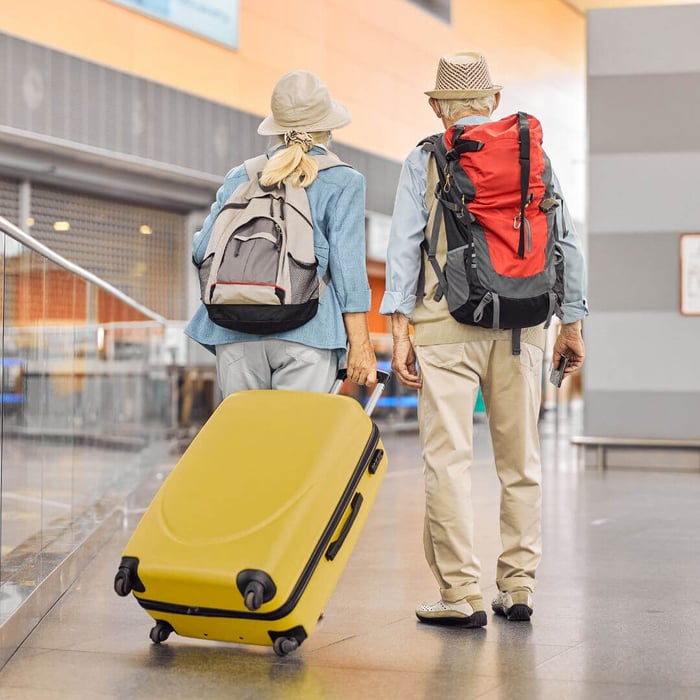Incontinence affects millions of people worldwide, and it can be attributed to several factors, including age, medical conditions and disabilities. It not only poses physical challenges but also affects the emotional well-being of individuals and their caregivers.
The fear of leaks, the need for frequent bathroom breaks, and the potential embarrassment can create anxiety and limit travel opportunities. However, it's worth remembering that incontinence need not define a person's life or restrict their ability to explore the world.
By equipping caregivers with knowledge, strategies and support, we can empower them to navigate the complexities of traveling with an incontinent patient and make every trip a positive and fulfilling experience.
Plan ahead
In the words of the late, great Yogi Berra, “If you don’t know where you are going, you’ll end up someplace else.” Whilst detailed plans may be a little over the top on short or routine trips, a bit of research could save a lot of heartache and frustration on longer trips.
Start by researching travel destinations that are accessible and appropriate for people with incontinence. Look for places that have easily accessible restroom facilities and accommodations that provide necessary amenities. Consider factors such as the availability of accessible transportation, proximity to medical facilities, and the overall accessibility of tourist attractions.
By doing thorough research, gathering information from reputable sources, and seeking recommendations from other caregivers, you can select destinations that cater to the patient’s specific requirements. This proactive approach will ensure a more comfortable and enjoyable trip, allowing the patient to fully participate in the travel experience while minimizing any potential challenges.
In a study conducted by THIIS (The Homecare Industry Information Service) in the UK, 68% of the disabled respondents reported avoiding specific tourist destinations because of a lack of accessible facilities. Although all incontinent people are not necessarily disabled, it is fair to say that the majority are older adults, many of whom start experiencing some degree of mobility impairment. This statistic would probably not be significantly different in the US.
Packing
As part of your care plan, you should have a list of all your patient’s medications and care supplies. Review this list and ensure you have an adequate supply of all the required medicines and supplies. Always take a little extra in case plans change along the way.
Consult with the healthcare provider or pharmacist to obtain the necessary prescriptions and pack them in a secure and easily accessible location. Consider using a pill organizer to keep medications organized and to ensure that doses are taken at the correct times and that none are missed.
Large quantities of absorbent products, such as adult diapers or pads can be pretty bulky. In case you can’t pack enough for the entire duration of the trip, find out whether you can buy them at your destination. Considering that you and your patient may spend more time out and about, it may also be prudent to switch to diapers with a higher absorbency level or take along some booster pads.
Include a selection of toiletries and sanitary products, including wipes, soap and hand sanitizer. In addition, bring an adequate supply of disposable gloves for yourself and your patient to use when handling incontinence products or during personal care routines. For advice and assistance in this area, you can contact LL Medico.
With more than 25 years of experience in incontinence products and personal care items, we can take all the worry out of your provisioning decisions and planning. With same-day delivery in the continental US, you could even arrange to have some supplies delivered to your destination.
Accommodation and Logistics
When traveling with an incontinent patient, overnight stays require some careful consideration and planning. Ensuring access to appropriate restroom facilities and selecting accommodations with incontinence-friendly features are key factors in providing a comfortable experience.
Before embarking on the trip, identify and locate accessible restroom facilities at travel destinations and en route. There are several smartphone apps and websites that provide information about accessible restrooms in different areas. This article reviews the best bathroom-finder apps.
Look for hotels or rental properties that offer accessible bathrooms equipped with features like grab bars, raised toilet seats and sufficient space for maneuvering, particularly if your patient has any mobility challenges. Some accommodations even provide incontinence-friendly amenities such as waterproof bedding and disposal bins for used products.
Fortunately, finding such accommodation and facilities is a somewhat easier. According to the Americans with Disabilities Act (ADA), public establishments in the United States are required to provide accessible restroom facilities to accommodate individuals with disabilities, including those with incontinence.
On overnight stays, protect the patient's bedding with waterproof covers or pads to prevent leakage onto the mattress. Consider using overnight absorbent products that offer maximum comfort and absorbency. Encourage the patient to empty their bladder before they go to bed and reduce or avoid fluid intake a few hours before sleep. Having a nightlight or easily accessible bedside commode may also help to make night-time bathroom visits a little easier.
Carry disposal bags designed for incontinence products to securely dispose of soiled items. If possible, locate designated disposal areas at your travel destinations to ensure proper waste management and compliance with local regulations. Additionally, it is helpful to have a small supply of cleaning products, such as stain removers or sanitizing wipes, to handle any accidents promptly and effectively.
When booking flights or trains, try to select seats close to the toilets and, whenever possible, request an aisle seat. If the budget permits, a seat with extra leg-room will be even better. This makes it much simpler for the patient to get up whenever necessary. If you’re traveling by car, plan regular stops along the route. If these options aren’t available, use higher-absorbency diapers or boosters for the duration of the journey.
Conclusion
American author Maya Angelou once said, "We may encounter many defeats, but we must not be defeated." While traveling with an incontinent patient may present some seemingly tricky challenges, proper planning and resourcefulness can help overcome them. Also, remember that you’re not alone in this journey. There is no need to figure everything out from scratch. Reach out for support and assistance. There are many associations and support groups that will give you all the advice and information that you need.







 855-422-4556
855-422-4556 Chat
Chat E-Mail
E-Mail Monday - Friday 9:00AM to 5:00PM EST
Monday - Friday 9:00AM to 5:00PM EST




 Shopping With LL Medico
Shopping With LL Medico
 855-422-4556
855-422-4556